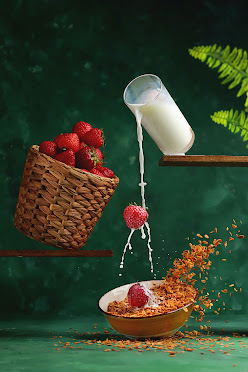Beyond Cows: Animal Nutrition and the Diversity of Milk Products Around the World
Introduction:
Milk
is a nutrient-rich fluid produced by mammals, primarily to nourish their
offspring. However, humans have been consuming milk from various animal sources
for thousands of years, recognizing its nutritional value and versatility in
culinary applications. Animal nutrition plays a vital role in the quality and
diversity of milk products around the world. In this blog, we will explore the
importance of animal nutrition in milk production and delve into the
fascinating array of milk products found across different cultures.
Part
1: Animal Nutrition and Milk Quality
 Animal
nutrition plays a critical role in determining the composition and quality of
milk. A well-balanced diet is crucial for the health and productivity of dairy
animals. By providing animals with the right combination of nutrients, farmers
can ensure optimal milk production and enhance the nutritional value of the
milk.
Animal
nutrition plays a critical role in determining the composition and quality of
milk. A well-balanced diet is crucial for the health and productivity of dairy
animals. By providing animals with the right combination of nutrients, farmers
can ensure optimal milk production and enhance the nutritional value of the
milk.
1.1.
Nutritional Requirements for Dairy Animals:
Dairy animals, such as cows, goats, and sheep, require a balanced diet that includes carbohydrates, proteins, fats, minerals, and vitamins. Carbohydrates, in the form of grains and forage, provide energy for milk production. Proteins are essential for muscle growth and milk protein synthesis. Fats contribute to milk fat content and energy density. Minerals and vitamins are necessary for overall health and metabolic functions.
To
meet the specific nutritional needs of dairy animals, farmers often work
closely with animal nutritionists. These professionals analyze the animal's
requirements and develop customized diets tailored to their needs. The diet
composition may vary based on factors such as the animal's age, breed, weight,
stage of lactation, and environmental conditions.
 Nutritional
supplements, such as mineral mixes, vitamins, and feed additives, are often
incorporated into the animals' diet to fill any nutritional gaps. These
supplements ensure that the animals receive all the necessary nutrients to
maintain their health and maximize milk production.
Nutritional
supplements, such as mineral mixes, vitamins, and feed additives, are often
incorporated into the animals' diet to fill any nutritional gaps. These
supplements ensure that the animals receive all the necessary nutrients to
maintain their health and maximize milk production.
The
quality of milk is directly influenced by the nutrition the animals receive.
When animals are fed a well-balanced diet, it leads to several positive
outcomes:
a)
Higher Milk Yield: Adequate nutrition promotes increased milk production.
Animals that receive the right amount and balance of nutrients are more likely
to produce higher quantities of milk.
b)
Improved Milk Composition: Animal nutrition affects the fat, protein, lactose,
and mineral content of milk. For example, a diet rich in fats can contribute to
higher milk fat content, while adequate protein intake ensures optimal milk
protein levels.
 c)
Enhanced Nutritional Value: Animals that receive proper nutrition produce milk
with a better nutritional profile. Milk from well-fed animals contains
essential nutrients like calcium, vitamins (A, B12, D), and minerals
(phosphorus, magnesium) that are important for human health.
c)
Enhanced Nutritional Value: Animals that receive proper nutrition produce milk
with a better nutritional profile. Milk from well-fed animals contains
essential nutrients like calcium, vitamins (A, B12, D), and minerals
(phosphorus, magnesium) that are important for human health.
1.4.
Animal Welfare and Productivity:
Proper
nutrition not only impacts milk quality but also plays a vital role in animal
welfare and productivity. When animals are provided with a balanced diet, they
experience better overall health, reduced susceptibility to diseases, and
improved reproductive performance. This leads to increased longevity and
productivity, ensuring a sustainable and ethical approach to milk production.
Part
2: Milk Products Around the World
 2.1.
Dairy Products in Europe:
2.1.
Dairy Products in Europe:
Europe
is renowned for its diverse range of milk products. Cheese is a significant
component of European culinary traditions, with each region boasting unique
varieties. France offers an array of cheeses, including Camembert, Brie, and
Roquefort, while Italy is famous for Parmesan, Mozzarella, and Gorgonzola. In
Greece, yogurt holds a prominent position, with its creamy texture and tangy
flavor widely enjoyed.
In
Asia, milk products are an integral part of the cuisine. Indian cuisine, for
instance, incorporates ghee (clarified butter) and paneer (cottage cheese) in
many dishes. In Mongolia, the nomadic herders produce airag, a traditional
fermented milk beverage. In Japan, matcha-flavored milk-based desserts, like
matcha ice cream and matcha lattes, have gained popularity worldwide.
The
Middle East showcases a rich variety of milk-based delights. One of the most
famous is labneh, a creamy strained yogurt often consumed with olive oil and
herbs. Another Middle Eastern specialty is kajmak, a thick clotted cream
enjoyed with bread or used in traditional pastries. Additionally, sahlab, a hot
milk-based beverage flavored with orchid powder, is a favorite during winter
months.
 2.4.
Latin American Favorites:
2.4.
Latin American Favorites:
Latin
American countries have their unique milk products too. In Mexico, sweetened
condensed milk is a common ingredient in desserts like tres leches cake.
Argentina is renowned for dulce de leche, a caramel-like milk-based spread
enjoyed on bread or used in pastries. In Brazil, queijo coalho, a salty cheese,
is often grilled and served as a street food delicacy.
Conclusion:
 The
diversity of milk products around the world is a testament to the importance of
animal nutrition in milk production. The quality of milk is directly influenced
by the animals' diet, ensuring optimal health and productivity. From Europe's
rich cheese traditions to Asia's fermented beverages and Latin America's sweet
delicacies, milk products play a vital role in global culinary heritage.
The
diversity of milk products around the world is a testament to the importance of
animal nutrition in milk production. The quality of milk is directly influenced
by the animals' diet, ensuring optimal health and productivity. From Europe's
rich cheese traditions to Asia's fermented beverages and Latin America's sweet
delicacies, milk products play a vital role in global culinary heritage.
 Understanding
the connection between animal nutrition and milk quality not only allows us to
appreciate the various milk products but also emphasizes the significance of
sustainable farming practices. As consumers, it is essential to support local
farmers who prioritize the well-being of their animals and maintain high
standards of nutrition. So, the next time you savor a slice of cheese, indulge
in a creamy yogurt, or relish a milk-based dessert, take a moment to
acknowledge the hard work and care that went into producing the milk that made
it possible. Animal nutrition contributes to the world's rich tapestry of milk
products, and by appreciating and supporting this diversity, we can continue to
enjoy these delicious treats for generations to come.
Understanding
the connection between animal nutrition and milk quality not only allows us to
appreciate the various milk products but also emphasizes the significance of
sustainable farming practices. As consumers, it is essential to support local
farmers who prioritize the well-being of their animals and maintain high
standards of nutrition. So, the next time you savor a slice of cheese, indulge
in a creamy yogurt, or relish a milk-based dessert, take a moment to
acknowledge the hard work and care that went into producing the milk that made
it possible. Animal nutrition contributes to the world's rich tapestry of milk
products, and by appreciating and supporting this diversity, we can continue to
enjoy these delicious treats for generations to come.

















Comments
Post a Comment